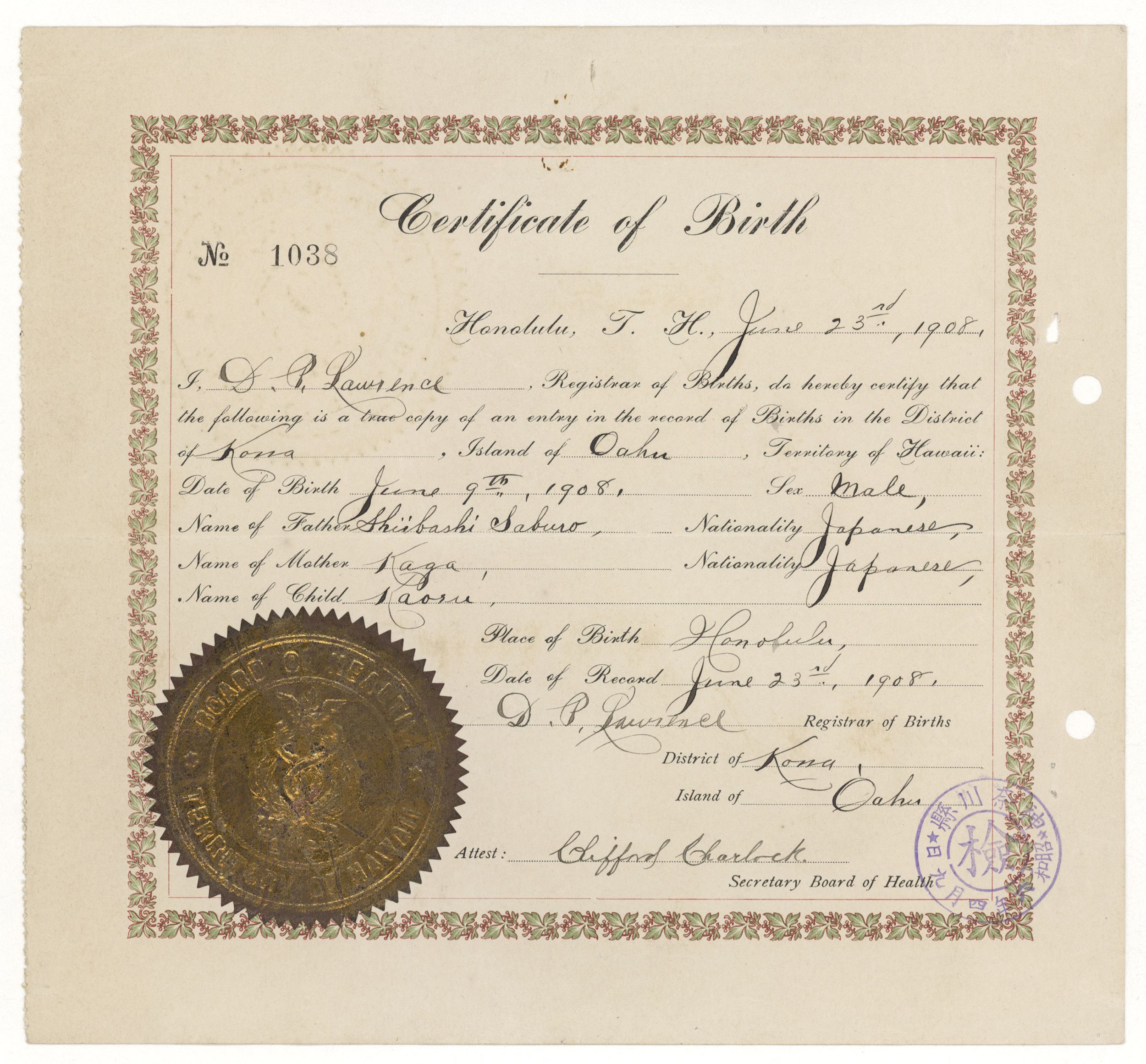Certificate of Birth of Kaoru Shiibashi
6/23/1908
Add to Favorites:
Add all page(s) of this document to activity:

The 1907 “Gentlemen’s Agreement” between the United States and Japan prevented male Japanese laborers from emigrating to the United States. The 1924 National Origins Act effectively ended all Japanese immigration. Thus, American citizens of Japanese ancestry living in Japan, who could legally return to the United States, were in great demand to work on Japanese farms in California.
In 1931, Kaoru Shiibashi, a 23 year old Hawaiian-born man who had been taken to Japan as a toddler, sailed to San Francisco “to see my native land” and to work on a farm near San Jose, California. When he arrived, immigration inspectors detained him on Angel Island and launched an investigation into his U.S. citizenship. Kaoru provided them with a family photograph of himself as an infant that was taken in Hawaii and with a copy of his Hawaiian birth certificate. However, the inspectors became suspicious when interviews with him and his family differed and no one in Hawaii could identify him in the photograph.
Kaoru was initially denied entry, but he was eventually admitted on appeal, and worked as a farm laborer in the strawberry fields for the next 10 years. During World War II, he was among 120,000 Japanese Americans detained under Executive Order 9066. After his release from the Heart Mountain internment camp in Wyoming, he returned to farm in California.
In 1931, Kaoru Shiibashi, a 23 year old Hawaiian-born man who had been taken to Japan as a toddler, sailed to San Francisco “to see my native land” and to work on a farm near San Jose, California. When he arrived, immigration inspectors detained him on Angel Island and launched an investigation into his U.S. citizenship. Kaoru provided them with a family photograph of himself as an infant that was taken in Hawaii and with a copy of his Hawaiian birth certificate. However, the inspectors became suspicious when interviews with him and his family differed and no one in Hawaii could identify him in the photograph.
Kaoru was initially denied entry, but he was eventually admitted on appeal, and worked as a farm laborer in the strawberry fields for the next 10 years. During World War II, he was among 120,000 Japanese Americans detained under Executive Order 9066. After his release from the Heart Mountain internment camp in Wyoming, he returned to farm in California.
This primary source comes from the Records of the Immigration and Naturalization Service.
National Archives Identifier: 6587579
Full Citation: Certificate of Birth of Kaoru Shiibashi; 6/23/1908; Immigration Arrival Investigation Case File for Kaoru Shiibashi (30309/27-5); Immigration Arrival Investigation Case Files, 1884–1944; Records of the Immigration and Naturalization Service, Record Group 85; National Archives at San Francisco, San Bruno, CA. [Online Version, https://www.docsteach.org/documents/document/certificate-of-birth-of-kaoru-shiibashi, April 18, 2024]Activities that use this document
- Ports of Immigration: Angel Island and Ellis Island
Created by the National Archives Education Team - Ports of Immigration: Angel Island and Ellis Island COPY
Created by the National Archives Education Team - Ports of Immigration: Angel Island and Ellis Island COPY (COPY)
Created by the National Archives Education Team
Rights: Public Domain, Free of Known Copyright Restrictions. Learn more on our privacy and legal page.



